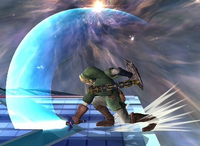An Edge getup, also known as an Edge recovery, is a set of moves that can be executed while a character is hanging on an edge. Along with grabbing the edge, these moves typically give a character invincibility frames to aid in recovery. It is often prudent to return to the stage before the invincibility frames expire. Edge getup maneuvers are sometimes used to edge-guard, especially when releasing and re-grabbing the ledge to refresh midair jumps. Edge getup moves also sometimes play a role in stalling.
Types of recovery movesEdit
There are five general recovery moves which may be performed while grabbing the edge. Prior to Super Smash Bros 4., each technique (with the exception of letting go of the ledge) becomes slower once the opponents percent is equal to or greater than 100%. Starting from Smash 4 however, the player's ledge options function identically regardless of the player's percent. The slower ledge options in earlier titles left the player on the ledge much more vulnerable to an on stage punish although they could keep hold onto the ledge for longer to edge hog more easily.
- Climb: By pushing the control stick towards the edge, the character will climb up onto the stage. Prior to Smash 4, when the character has 100% damage or more, the action of climbing back to the stage is significantly slower.
- Attack: By pressing an attack button, a character will climb up onto the stage while performing an edge attack. This is primarily useful when the opponent is next to the edge, as a counter attack. Prior to Ultimate, the amount of intangibilty ledge attacks had varied from character to character, ending shortly before the hitboxes became active in a vast majority of cases. In Ultimate, attacks are intangible until hitboxes are no longer active. Prior to Smash 4, when the character has 100% damage or more, they will perform a different, significantly slower ledge attack. On the plus side however, almost all edge attacks deal more damage (except for Captain Falcon's) and the character still has invincibility frames when hitboxes are active, unlike with most normal edge attacks. Over 100% ledge attacks can have other advanatges/disadvantages such as more/less range or more/less relative ending lag.
- Roll: By pressing a shield button, a character will climb up and roll forward a moderate distance. Prior to Smash 4, when the character has 100% damage or more, ledge rolling is significantly slower, however the roll itself covers slightly more distance.
- Jump: Introduced in Melee, by pressing a jump button or pushing the analog stick up, a character will leap upwards and slightly forward. The jump has two parts: jumping off the ledge and the actual jump itself. The jump off the ledge is intangible but the player is vulnerable once they are jumping (although in Melee and Brawl, the player can carry their ledge intangibility into the jump). In Melee, the player is stuck in the jumping animation (which is fairly lengthy) and they cannot do anything until the animation is over, leaving them very vulnerable. Carrying over ledge intangibility can alleviate this although in a vast majority of cases, this is not enough. Ledge jumps in Melee are largely useless outside of specific cases as they are too slow, they are too punishable and they are heavily outclassed by simply dropping off the ledge and jumping back onto the stage (with ledge jumps jokingly having the nickname tournament winner due to its big risk). Starting from Brawl however, the player can immediately act out of the ledge jump, making it far more useful and much harder to punish. The player can quickly attack or edge dodge with the opponent having a very small punish window. In Brawl specifically, if the player carries over ledge intangibility to the ledge jump, they are fully intangible for a period of time during the ledge jump, allowing for fully intangible air dodges and attacks. Prior to Smash 4, when the character has 100% damage or more, jumping off the ledge is slightly slower although the speed decrease is much less severe compared to other ledge options.
- Letting go: By pressing the control stick away from an edge or downwards, a character will let go of the edge and they can immediately act. This gives the opponent access to any aerial options which can be useful for getting back onto the stage or edgeguarding. This is especially powerful in Melee and Brawl as the player can carry over their ledge intangibility which can allow for some extremely powerful ledge sequences.
Inputs in Super Smash Bros. MeleeEdit
Sorted by priority. For example, pressing and at the same frame will result in an edge attack.
- Attack: Press , , or move the upwards.
- Roll: Press , or move the towards the stage.
- Jump: Press , or move the upwards.
- Climb: up / towards (for all possible value combinations, see the image on the right).
- Let go: down / away (for all possible value combinations, see the image on the right) or away or down.
Edge attacksEdit
| Attacks in the Super Smash Bros. series | |
|---|---|
| Standard ground attacks | Neutral attack · Dash attack |
| Tilt attacks | Forward tilt · Up tilt · Down tilt · Crouching attack |
| Smash attacks | Forward smash · Up smash · Down smash |
| Aerial attacks | Neutral aerial · Forward aerial · Back aerial · Up aerial · Down aerial · Grab aerial · Glide attack |
| Throws | Grab · Pummel · Forward throw · Back throw · Up throw · Down throw |
| Get-up attacks | Floor attack · Edge attack |
| Special moves | Neutral special move · Side special move · Up special move · Down special move · Command-input move · Final Smash |
